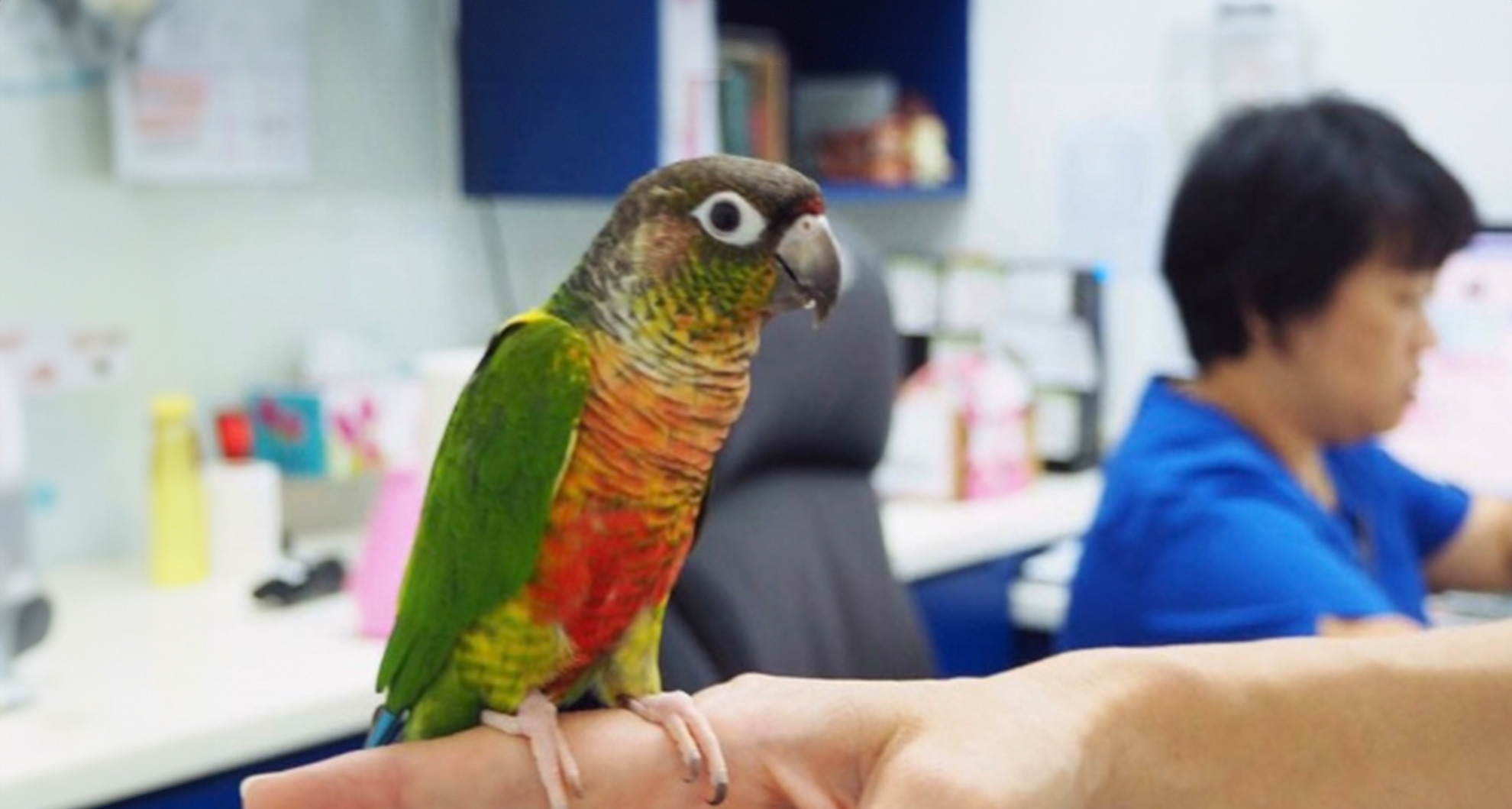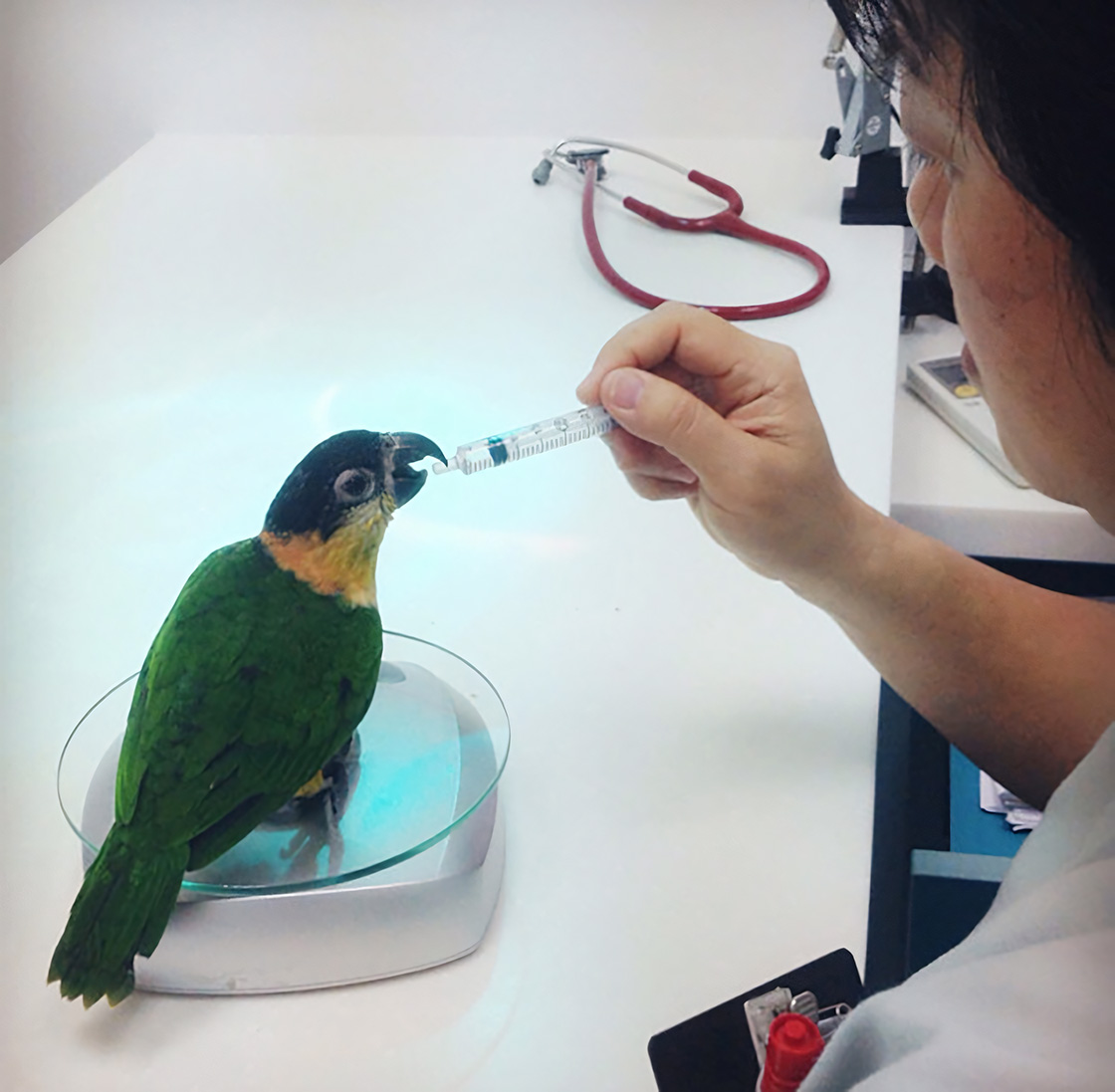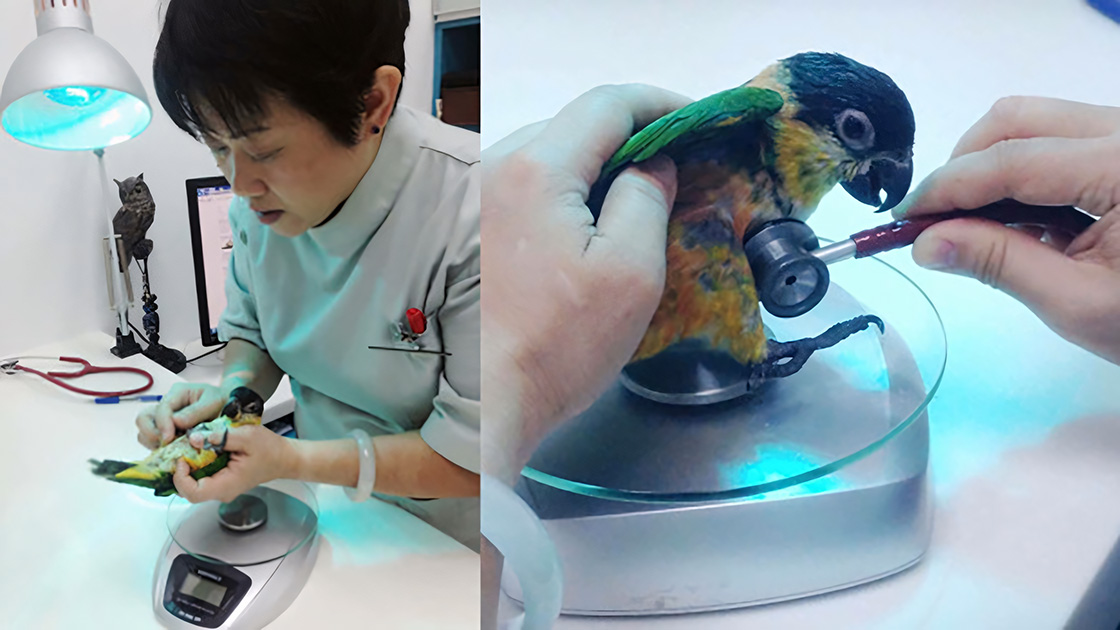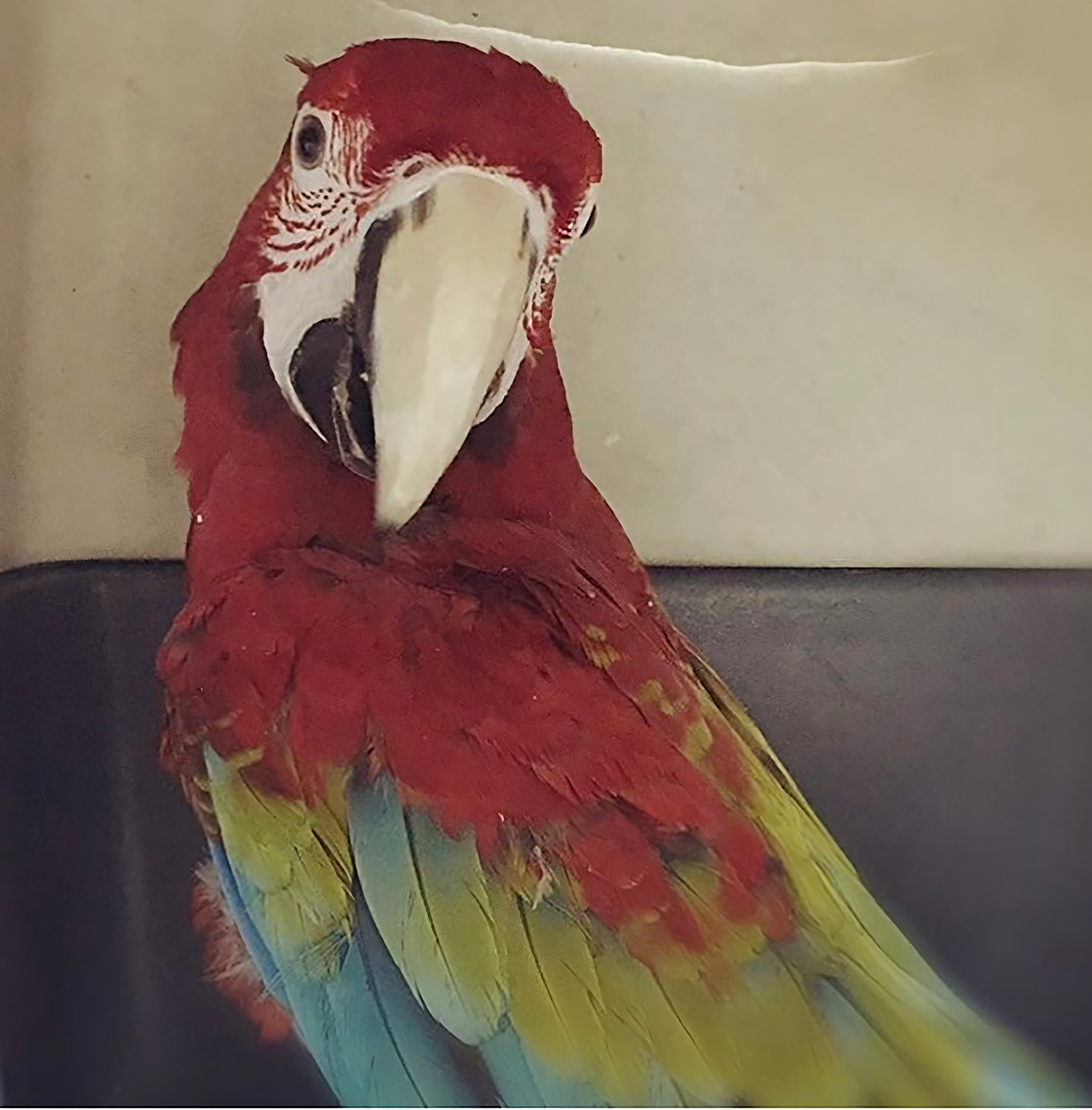Parrot Care: 7 Common Mistakes



"Keeping birds as pets is a popular hobby in Singapore. In recent years, more people have gravitated towards keeping smaller parrots as they can be excellent companions and are easier to keep in a flat or apartment without needing large cages. In this article, I share some mistakes often seen when I consult these birds and their owners." - Dr. Gloria Lee, Mount Pleasant Mandai”
Mistake 1: My parrots are seed eaters
Although parrots are mainly seed eaters, their diet in captivity should include less seeds and more fresh fruits and vegetables and other wholesome healthy human foods. In the wild, parrots fly great distances foraging for fruits, nuts, and seeds. A seed-only diet is low in calcium and high in fat, often causing obesity and eventually liver disease.
- commonly eaten fruits are all edible for parrots, except avocado and seeds of certain fruits like apples, pears, peaches, and apricots.
- all vegetables are edible, although some have to be cooked, e.g., broccoli, pumpkin, sweet potato, potato, dried peas/lentils.
- other wholesome human foods that are acceptable include hard-boiled egg, bread, pasta, rice, egg noodles.
- feed in moderation and in great variety. These foods spoil faster so care must be taken to keep food containers and perches well scrubbed. Dispose uneaten foods within a few hours.
Mistake 2: My parrots need to shower to keep clean
Whilst true, never shower a bird that looks less than healthy, and always make sure they are placed in the sun to preen and dry off. It is unnecessary to hose them wet to the skin. Sometimes, it is adequate to place a shallow bowl of water on the cage floor or use a bottle sprayer. Some birds do not like to shower, and it is a source of stress if they are hosed down strongly. Always watch how your birds react.
Mistake 3: Putting my sick birds in the sun will keep it warm
A bird’s core body temperature is 40°C. The environmental temperature in Singapore rarely goes above 33°C. A heating lamp (infra-red or basic non-energy saving light bulb) does a better job at raising the temperature of a hypothermic bird. To avoid accidentally over-heating your bird, place your hand next to your bird – it should feel comfortably toasty warm. Adjust the distance between the lamp and your bird to get the right temperature. Position the lamp to one side so that your bird can get away from direct light if it feels too hot.

Mistake 4: Glucose or honey water is the most important first aid for sick birds
If a bird a very sick and weak, it may not be able to swallow adequately. Dripping water into its beak can cause it to drown as the water gets into the lungs instead. The most important first aid for sick birds is warmth. After you have raised the ambient temperature to support your sick bird’s recovery, make sure it is getting sufficient food and fluids. You may have to hand feed till it regains a normal appetite. Keep your ill or injured bird quiet, warm, and inactive.

Mistake 5: It is alright if my bird does not eat for a day
Birds have an extremely high metabolic rate, and a high body surface area compared to body mass. This means they burn up food very fast in order to stay warm and keep their body functioning. They must be checked by a vet as soon as possible if you notice a much reduced appetite. Never leave it for 2 to 3 days – often that may be too late. During a physical examination, Dr Gloria Lee carefully evaluates the eyes, nares, beak, plumage, vent, legs etc. The heart and lungs are assessed by auscultation with a neonatal stethoscope.

Mistake 6: It is cruel to cage a bird – use a T-stand or allow it to free range
Only acquire captive-bred parrots, never wild-caught ones. They adapt to a roomy cage very well. Cages keep them safe. An untrained bird left to roam or on a T-stand can suffer severe accidents such as fractured legs, poisoning or trauma to the digestive tract when they chew poisonous houseplants or electrical cords etc. I have seen many cases of birds injured from flying into fans – they suffer bad concussions or need to have a wing or leg amputated.
Mistake 7: Parrots can be left in their cage the whole day as long as they have food and toys
The term ‘bird brain’ to describe dim-witted people was obviously coined by someone who does not keep parrots. Frustration, stress, and anxiety are often felt by parrots, especially those that are hand-raised very well and very tame. Self-destructive behaviour and Obsessive Compulsive Disorders (OCD) are well-recognised psychological diseases which are very difficult to treat. Do not even consider having a parrot unless you can dedicate several hours to them daily. Since some parrots like the Cockatoo can live to 80 years old, be prepared, like me, to include for their care in your Will.
Dr Gloria Lee, Bird Vet, Mount Pleasant Vet Centre (Mandai)

"Keeping birds as pets is a popular hobby in Singapore. In recent years, more people have gravitated towards keeping smaller parrots as they can be excellent companions and are easier to keep in a flat or apartment without needing large cages. In this article, I share some mistakes often seen when I consult these birds and their owners." - Dr. Gloria Lee, Mount Pleasant Mandai”
Mistake 1: My parrots are seed eaters
Although parrots are mainly seed eaters, their diet in captivity should include less seeds and more fresh fruits and vegetables and other wholesome healthy human foods. In the wild, parrots fly great distances foraging for fruits, nuts, and seeds. A seed-only diet is low in calcium and high in fat, often causing obesity and eventually liver disease.
- commonly eaten fruits are all edible for parrots, except avocado and seeds of certain fruits like apples, pears, peaches, and apricots.
- all vegetables are edible, although some have to be cooked, e.g., broccoli, pumpkin, sweet potato, potato, dried peas/lentils.
- other wholesome human foods that are acceptable include hard-boiled egg, bread, pasta, rice, egg noodles.
- feed in moderation and in great variety. These foods spoil faster so care must be taken to keep food containers and perches well scrubbed. Dispose uneaten foods within a few hours.
Mistake 2: My parrots need to shower to keep clean
Whilst true, never shower a bird that looks less than healthy, and always make sure they are placed in the sun to preen and dry off. It is unnecessary to hose them wet to the skin. Sometimes, it is adequate to place a shallow bowl of water on the cage floor or use a bottle sprayer. Some birds do not like to shower, and it is a source of stress if they are hosed down strongly. Always watch how your birds react.
Mistake 3: Putting my sick birds in the sun will keep it warm
A bird’s core body temperature is 40°C. The environmental temperature in Singapore rarely goes above 33°C. A heating lamp (infra-red or basic non-energy saving light bulb) does a better job at raising the temperature of a hypothermic bird. To avoid accidentally over-heating your bird, place your hand next to your bird – it should feel comfortably toasty warm. Adjust the distance between the lamp and your bird to get the right temperature. Position the lamp to one side so that your bird can get away from direct light if it feels too hot.

Mistake 4: Glucose or honey water is the most important first aid for sick birds
If a bird a very sick and weak, it may not be able to swallow adequately. Dripping water into its beak can cause it to drown as the water gets into the lungs instead. The most important first aid for sick birds is warmth. After you have raised the ambient temperature to support your sick bird’s recovery, make sure it is getting sufficient food and fluids. You may have to hand feed till it regains a normal appetite. Keep your ill or injured bird quiet, warm, and inactive.

Mistake 5: It is alright if my bird does not eat for a day
Birds have an extremely high metabolic rate, and a high body surface area compared to body mass. This means they burn up food very fast in order to stay warm and keep their body functioning. They must be checked by a vet as soon as possible if you notice a much reduced appetite. Never leave it for 2 to 3 days – often that may be too late. During a physical examination, Dr Gloria Lee carefully evaluates the eyes, nares, beak, plumage, vent, legs etc. The heart and lungs are assessed by auscultation with a neonatal stethoscope.

Mistake 6: It is cruel to cage a bird – use a T-stand or allow it to free range
Only acquire captive-bred parrots, never wild-caught ones. They adapt to a roomy cage very well. Cages keep them safe. An untrained bird left to roam or on a T-stand can suffer severe accidents such as fractured legs, poisoning or trauma to the digestive tract when they chew poisonous houseplants or electrical cords etc. I have seen many cases of birds injured from flying into fans – they suffer bad concussions or need to have a wing or leg amputated.
Mistake 7: Parrots can be left in their cage the whole day as long as they have food and toys
The term ‘bird brain’ to describe dim-witted people was obviously coined by someone who does not keep parrots. Frustration, stress, and anxiety are often felt by parrots, especially those that are hand-raised very well and very tame. Self-destructive behaviour and Obsessive Compulsive Disorders (OCD) are well-recognised psychological diseases which are very difficult to treat. Do not even consider having a parrot unless you can dedicate several hours to them daily. Since some parrots like the Cockatoo can live to 80 years old, be prepared, like me, to include for their care in your Will.
Dr Gloria Lee, Bird Vet, Mount Pleasant Vet Centre (Mandai)

"Keeping birds as pets is a popular hobby in Singapore. In recent years, more people have gravitated towards keeping smaller parrots as they can be excellent companions and are easier to keep in a flat or apartment without needing large cages. In this article, I share some mistakes often seen when I consult these birds and their owners." - Dr. Gloria Lee, Mount Pleasant Mandai”
Mistake 1: My parrots are seed eaters
Although parrots are mainly seed eaters, their diet in captivity should include less seeds and more fresh fruits and vegetables and other wholesome healthy human foods. In the wild, parrots fly great distances foraging for fruits, nuts, and seeds. A seed-only diet is low in calcium and high in fat, often causing obesity and eventually liver disease.
- commonly eaten fruits are all edible for parrots, except avocado and seeds of certain fruits like apples, pears, peaches, and apricots.
- all vegetables are edible, although some have to be cooked, e.g., broccoli, pumpkin, sweet potato, potato, dried peas/lentils.
- other wholesome human foods that are acceptable include hard-boiled egg, bread, pasta, rice, egg noodles.
- feed in moderation and in great variety. These foods spoil faster so care must be taken to keep food containers and perches well scrubbed. Dispose uneaten foods within a few hours.
Mistake 2: My parrots need to shower to keep clean
Whilst true, never shower a bird that looks less than healthy, and always make sure they are placed in the sun to preen and dry off. It is unnecessary to hose them wet to the skin. Sometimes, it is adequate to place a shallow bowl of water on the cage floor or use a bottle sprayer. Some birds do not like to shower, and it is a source of stress if they are hosed down strongly. Always watch how your birds react.
Mistake 3: Putting my sick birds in the sun will keep it warm
A bird’s core body temperature is 40°C. The environmental temperature in Singapore rarely goes above 33°C. A heating lamp (infra-red or basic non-energy saving light bulb) does a better job at raising the temperature of a hypothermic bird. To avoid accidentally over-heating your bird, place your hand next to your bird – it should feel comfortably toasty warm. Adjust the distance between the lamp and your bird to get the right temperature. Position the lamp to one side so that your bird can get away from direct light if it feels too hot.

Mistake 4: Glucose or honey water is the most important first aid for sick birds
If a bird a very sick and weak, it may not be able to swallow adequately. Dripping water into its beak can cause it to drown as the water gets into the lungs instead. The most important first aid for sick birds is warmth. After you have raised the ambient temperature to support your sick bird’s recovery, make sure it is getting sufficient food and fluids. You may have to hand feed till it regains a normal appetite. Keep your ill or injured bird quiet, warm, and inactive.

Mistake 5: It is alright if my bird does not eat for a day
Birds have an extremely high metabolic rate, and a high body surface area compared to body mass. This means they burn up food very fast in order to stay warm and keep their body functioning. They must be checked by a vet as soon as possible if you notice a much reduced appetite. Never leave it for 2 to 3 days – often that may be too late. During a physical examination, Dr Gloria Lee carefully evaluates the eyes, nares, beak, plumage, vent, legs etc. The heart and lungs are assessed by auscultation with a neonatal stethoscope.

Mistake 6: It is cruel to cage a bird – use a T-stand or allow it to free range
Only acquire captive-bred parrots, never wild-caught ones. They adapt to a roomy cage very well. Cages keep them safe. An untrained bird left to roam or on a T-stand can suffer severe accidents such as fractured legs, poisoning or trauma to the digestive tract when they chew poisonous houseplants or electrical cords etc. I have seen many cases of birds injured from flying into fans – they suffer bad concussions or need to have a wing or leg amputated.
Mistake 7: Parrots can be left in their cage the whole day as long as they have food and toys
The term ‘bird brain’ to describe dim-witted people was obviously coined by someone who does not keep parrots. Frustration, stress, and anxiety are often felt by parrots, especially those that are hand-raised very well and very tame. Self-destructive behaviour and Obsessive Compulsive Disorders (OCD) are well-recognised psychological diseases which are very difficult to treat. Do not even consider having a parrot unless you can dedicate several hours to them daily. Since some parrots like the Cockatoo can live to 80 years old, be prepared, like me, to include for their care in your Will.
Dr Gloria Lee, Bird Vet, Mount Pleasant Vet Centre (Mandai)
